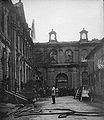User:Dr Gangrene/Mettlach Abbey
The Abbey of Saint Peter and Mary in Mettlach was a Benedictine abbey that was founded in the late 7th century. The abbey buildings, which were abandoned in the French Revolution, are now the seat of the firm Villeroy & Boch.
History
[edit]In the late 7th century, the Frankish nobleman Lutwinus founded the abbey of St. Peter and Maria as a dual convent in what is now known as Mettlach, and entered the monastery himself, which was under the Benedictine Rule. When Leudwinus later became Bishop of Trier (697-715) (as well as of Reims (717) and Laon), the result was that over several centuries, until the 10th century, the diocese of Trier and the abbey were led by the same person, in personal union.
Already in 757/768, Lantbert, wohl ein Verwandter Liutwins und Stammvater der Guideschi, acquired the abbey of Mettlach in seinen Besitz, wohl 782 wies dann King Charlemagne die daraus abgeleiteten Ansprüche von Lantberts Söhnen, darunter Guy of Nantes, auf Mettlach ab. Afterwards the Carolingians up until the 9th century, especially Emperor Lothair I, exercised royal rights in Mettlach, who as the beginning of his rule granted ownership to the later Duke Guy I of Spoleto, the grandson of Guy of Nantes, in den Besitz des Klosters setzte. Nach dem Ende des karolingischen Herrscherhauses war die Abtei Mettlach dann ein Eigenkloster des Bistums.
The personal union ended when Bishop Rotbert of Trier (931-956) granted the monastery the right to elect its own abbot. It was also Rotbert who diverted a Pentecost procession, which had hitherto led to the Cathedral of Trier, so that it led towards Mettlach, and thereby started the tradition of Mettlach as a place of pilgrimage.
Around 990, abbot Lioffin founded a church dedicated to St Mary, as a burial church for the founder. This church, in the form of an octagon (inspired by Aachen Cathedral) is now known as the "Old Tower" (Alter Turm) and represents the oldest building in the Saarland. The Romanesque building, and a piece of the True Cross acquired in the 1220s, are a testament of the importance of the abbey in the Middle Ages. Furthermore, its importance is shown by texts originating in Mettlach in the realms of hagiography and homiletics, as well as correspondence with Gerbert of Aurillac, the later Pope Silvester II. In 1468, the Benedictine abbey under abbot Arnold de Clivis joined the Bursfelde Congregation, and formally remained in this union of monasteries until its dissolution in 1802. In the 18th century, the Late Baroque abbey buildings were constructed under Johann Bernhard Trabucco and Christian Kretzschmar. The building of the the new abbey church was not completed before the abbey was dissolved.
The French Revolution, and especially the War of the First Coalition from 1792, signalled the end of the abbey of Mettlach. In 1793-1794, the abbey was abandoned. The current abbey buildings, which date from the 18th century, were declared to be property of the French nation in 1802, in the course of secularisation. It was then sold to the paper manufacturer Leistenschneider from Trier. He in turn sold it in 1809 to Jean-François Boch, who belonged to the third generation of the Boch family, and who repaired and renovated the now delapidated buildings. In doing so, he renovated part of it for use as a factory. The building remains until this day the headquarters of the firm Villeroy & Boch. On 13 August 1921, the buildings were heavily damaged by a massive fire.[1]
-
Lithography of the old abbey in 1863, with the Old Tower on the right
-
The old abbey, now hte headquarters of Villeroy & Boch
-
Old abbey after the fire of 13 August 1921
-
Inner court of the old abbey after the fire of 13 August 1921
-
The old abbey in 2011
Further reading
[edit]- Historische Stätten Deutschlands. Vol. V. pp. 235f.
- Becker, Petrus (1999). Jürgensmeier, Friedhelm; Schwerdtfeger, Regina Elisabeth (eds.). Mettlach. St. Ottilien.
{{cite book}}:|work=ignored (help)CS1 maint: location missing publisher (link) - Flesch, Stefan (1991). Die monastische Schriftkultur der Saargegend im Mittelalter. Veröffentlichungen der Kommission für saarländische Landesgeschichte. Vol. 20.
- Klewitz, Martin (1975). Zur Baugeschichte der Benediktinerabtei Mettlach. 1300 Jahre Mettlach.
- Lager, J. C. (1875). Urkundliche Geschichte der Abtei Mettlach. Trier.
{{cite book}}: CS1 maint: location missing publisher (link) - Volkelt, Peter (1969). Die Bauskulptur und Ausstattungsbildnerei des frühen und hohen Mittelalters im Saarland. Veröffentlichungen des Instituts für Landeskunde im Saarland. Vol. 16. Saarbrücken.
{{cite book}}: CS1 maint: location missing publisher (link) - Raach, Theo (1974). Kloster Mettlach/Saar und sein Grundbesitz. Untersuchungen zur Frühgeschichte und Grundherrschaft der ehemaligen Benediktinerabtei im Mittelalter. Quellen und Abhandlungen zur mittelrheinischen Kirchengeschichte. Vol. 19. Mainz: Gesellschaft für mittelrheinische Kirchengeschichte.
- Maas, J. (1956). Die Mettlacher Pfingstprozession, eine umgewandelte Kathedralprozession. Trier.
{{cite book}}: CS1 maint: location missing publisher (link) - Herrmann, Hans-Walter (1993). "Mettlach". Lexikon des Mittelalters. Vol. 6. Munich/Zürich: Artemis & Winkler. ISBN 3-7608-8906-9.
dff
- Petrus Becker OSB: Mettlach, in: Friedhelm Jürgensmeier/Regina Elisabeth Schwerdtfeger (Hrsg.): Die Männer- und Frauenklöster der Benediktiner in Rheinland-Pfalz und Saarland, (Germania Benedictina Bd. IX), EOS-Verlag, St. Ottilien 1999, 517 - 545. ISBN 3-88096-609-5.
- J. Maas: Die Mettlacher Pfingstprozession, eine umgewandelte Kathedralprozession. Trier 1956 (Wiss. Arbeit der Trierer theol. Fakultät. Maschinenschrift).
External links
[edit]References
[edit]- ^ "Historie Firmensitz Villeroy & Boch" (in German). Retrieved 2013-07-01.




